Apple's 15-inch Core i5 MacBook Pro: The One to Get?
by Anand Lal Shimpi on April 14, 2010 10:38 PM EST- Posted in
- Mac
- MacBook Pro
- Arrandale
- Core i5
- Laptops
They’re Actually Faster
Benchmarking under OS X isn’t difficult, you just need to get creative. Luckily I’m in dire need of creative outlets so creating OS X benchmarks works for me. I’m using the same tests I introduced in my Holiday 2009 Macbook Pro roundup and running on the same hardware (specs listed in the tables on the previous pages). The Core i5 system is the new entry level 15-inch MacBook Pro.
We’ll start with general application performance.
General OS usage is a difficult thing to quantify, but one measure of performance has always been the number of bounces an icon in the dock makes before an application loads. I decided to take it to the next level and write a quick script to launch 15 applications in a row, timing how long the entire process takes.
I launched, in order: Mail, Safari, Activity Monitor, iTunes, iCal, DVD Player, iPhoto, Photo Booth, Quicktime Player, Disk Utility, Preview, iMovie, Front Row, Garage Band and Aperture.
The entire process stresses both the disk and CPU, which is why we see a huge improvement when going to an SSD as well as differences between CPU speeds.
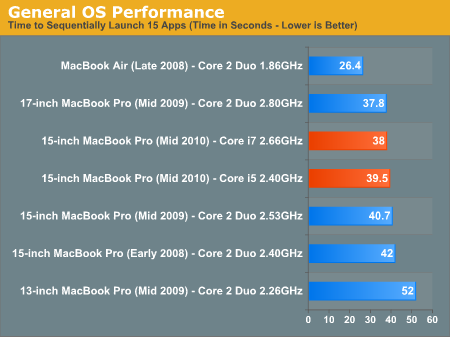
My application launch test absolutely rocks on the MacBook Air because it ships with an SSD by default. The MacBook Pros are stuck with mechanical hard drives and thus don’t perform nearly as well. If you’re curious, installing an Intel X25-M G2 in any of the MBPs will drop their times to 16 seconds or less.
The new MacBook Pro also doesn’t improve performance that much. I measured a 3% increase in performance, which although repeatable, isn’t really spectacular. This is compared to the old 2.53GHz Core 2 Duo and should serve as a baseline for the minimum performance improvement you should see. In other words, the 2.4GHz 15-inch MacBook Pro should perform no worse than last year’s 2.53GHz model.
The $2199 model with a Core i7 running at 2.66GHz pushes performance up another 3.9% over the base model. That's actually more than I expected but the real strength of the i7 is visible in the more CPU bound tests.
Adobe Photoshop CS4 Performance
The Retouch Artists Speed Test we use for our CPU testing under Windows also works under OS X. We're running the exact same benchmark here, basically performing a bunch of image manipulations and filters and timing the entire process.
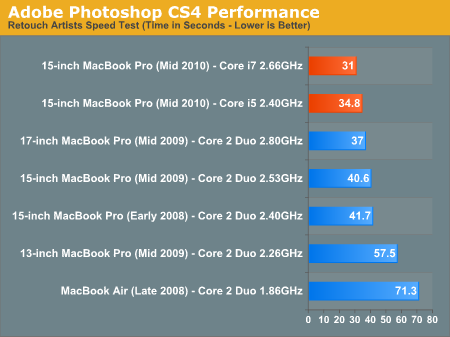
The old 13-inch MacBook Pro is penalized by only shipping with 2GB of memory, which is why it performs so poorly here. The real comparison is between the 2.4GHz Core i5 vs. the 2.53GHz Core 2 Duo from last year. The former is 16.6% faster in our Photoshop test. In fact, the new 15-inch MacBook Pro is even faster than the older 2.80GHz 17-inch model I reviewed.
The Core i7 model is 12.3% faster than the baseline Core i5 2.40GHz. Definitely noticeable.
Aperture 2 RAW Import
For my Aperture test I simply timed how long it took to import 203 12MP RAW images into the library.
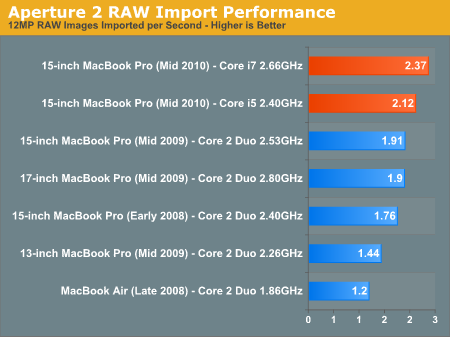
The new entry level 15-inch MBP is 10.9% faster than the old MacBook Pro, and again, it’s faster than the old 17-inch model as well. Moving to the Core i7 gives you another 11.8%.
Cinebench R10
I’m a fan of the Cinebench test because it lets me show off both single and multithreaded performance in the same workload. First, the single threaded performance:
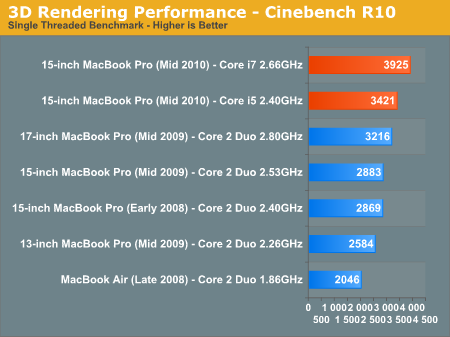
Here we have a huge advantage on the new MacBook Pro. Intel’s Turbo Boost is active here, resulting in a large performance advantage, not to mention all of the enhancements present in the Nehalem/Arrandale architectures. This is one of the best situations for the Core i7 vs. the i5. The extra $400 gives you another 14.7%, not bad at all.
Multithreaded performance is equally impressive:
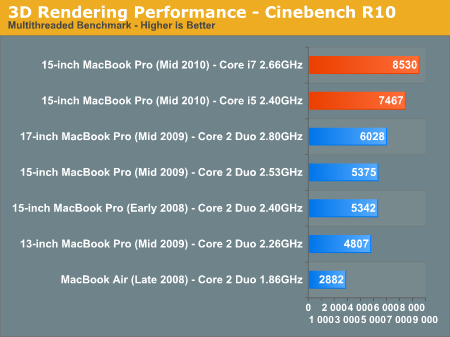
Thanks to Hyper Threading, the new Core i5 puts a generational gap between itself and last year’s MacBook Pro in this test. Whether you’re running single threaded or multithreaded applications, the Core i5 can be noticeably faster than the Core 2 Duo.
Quicktime H.264 Video Encoding
Our final benchmark is more consumer focused. Here I'm taking an XviD and converting it to an iPhone-supported H.264 format.
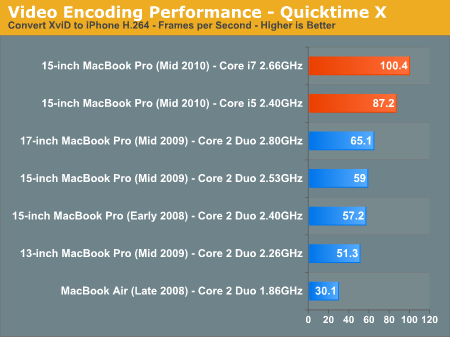
Video encoding is one of the i5’s definite strengths. If you do a lot of video encoding on your notebook, the jump from Core 2 to i5 is tremendous - approaching 50% in this case even despite the “lower” default clock speed. This is also the best showing for the Core i7 - count on an extra 15% over the base Core i5.
Core i7 vs. Core i5 Performance Summary
The two Core i5 models Apple offers ship with a 2.40GHz or 2.53GHz processor, both with a 3MB L3 cache. The $2199 15-inch MacBook Pro comes with a 2.66GHz Core i7, with a full 4MB L3 cache. Compared to the entry level model that's an 11% increase in clock speed and a 33% increase in L3 cache.
While I don't believe there's much reason to go for the 2.53GHz over the 2.40GHz model (L3 cache size remains the same, clock speed goes up by a small amount), the Core i7 is actually pretty decent. For a 22% increase in total system cost you end up with 11 - 15% better performance in CPU bound applications. It actually even feels snappier in general use as well.
I'd still suggest opting for an SSD before considering any CPU upgrades, but if you're looking to keep your new MacBook Pro for a while the Core i7 is worth it.










114 Comments
View All Comments
ReaM - Friday, April 16, 2010 - link
I think the update is not worth paying the extra for.330GT is not much better than 9600GT and the Core2Duo in overall is not that much faster. It feels I will pay more for just a slight improvement.
For 1700buck you can build a i7 980X Six core computer and be happy with 30,000 cinebench scores.
I am having my 10nth mac right now, but they seem to get more expensive for what they can do. If you add the 1050 display, that's gonna cost you even more.
I hoped for more.
ReaM - Friday, April 16, 2010 - link
The new MagSafe connector seems to be crappy. If pulled on cord, because if it is now vertical direction, will pull the whole macbook with it.overzealot - Friday, April 16, 2010 - link
I want some on my 5770overzealot - Friday, April 16, 2010 - link
Far more fun than stream processorsDanaGoyette - Friday, April 16, 2010 - link
No USB 3.0? And no ExpressCard slot, so you can't add it later? FAIL. Oh, here's an SD Card slot for you, instead. Good luck trying to connect an external hard drive to that.Frankly, Apple's MacBook "Pro" line is thoroughly outclassed by HP's "EliteBook" series. Rather than making myself sound like a rabid fanboy by describing why, I'll just link to this:
http://hpfansite.com/category/hp-elitebook/
kuwan - Friday, April 16, 2010 - link
Just a comment on the Aperture 2 RAW Import...Importing RAW images is actually more disk bound than it is CPU bound - at least it is in Bibble 5. It usually involves decoding to a low-resolution image and saving a preview which can often be done faster than the disk can read the files. If you're looking for a CPU benchmark then exporting the images to JPEG after you've imported them will likely give you a much better metric on how the CPUs perform.
Also, why not use Bibble 5 as a RAW image benchmark? ;-) I've seen it included in a number of CPU reviews and it runs just as well on Mac OS X as it does under Windows or Linux. Aperture doesn't actually scale very well with multiple CPUs/threads so it isn't a particularly good CPU benchmark now that 2-4 cores is pretty much standard. Also, the nice thing about Bibble as a benchmark is that we actually report the times it takes to run a batch - so you won't have to use a stop watch. ;-)
Anyway, thanks as always for a great review.
Note that I'm the lead Mac engineer for Bibble Labs.
Cheers
I am as mad as hell - Friday, April 16, 2010 - link
No (Cr)apple product reviews on Anandtech please! Make this site Apple free. There are tons of other sites devoted to the "other" OS. Thanks you.TEAMSWITCHER - Friday, April 16, 2010 - link
Don't you think that you should be a bit more open minded? There are a lot of AnandTech readers and many of us look forward to reading the Apple coverage. No one is forcing to read the Apple related material.webdev511 - Sunday, April 18, 2010 - link
Apple computers do a great job at running Windows. I enjoy reading reviews of Apple hardware. If AnandTech hadn't reviewed this crop of MacBook Pros, I would never have know that they fall short of what I expected.I'd actually like to see a Spring 2010 Laptop shoot out that includes the MBP running the same OS as the rest. It would be a great way to see how Apple hardware stacks up to the rest of what's out there.
Tempsis - Monday, April 19, 2010 - link
My only issue is that, these days, it seems like the only notebook systems that get deemed worthy of Anand's review time are Apple's system. All of the other notebook reviews get dealt out to other writers, but when it comes to Apple-based information/product reviews, only Anand seems to do it/etc. Seems to indicate a favoritism towards Apple on Anand's part.